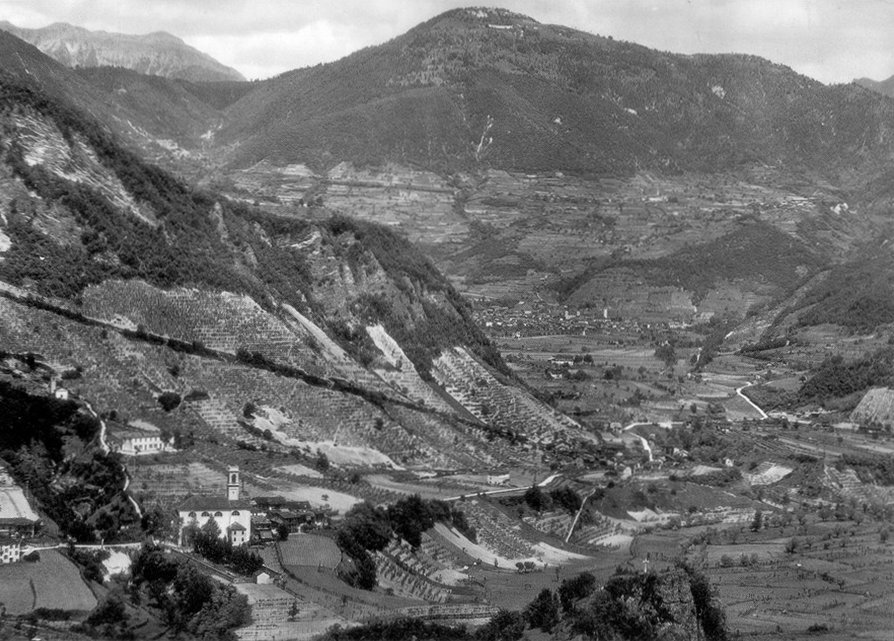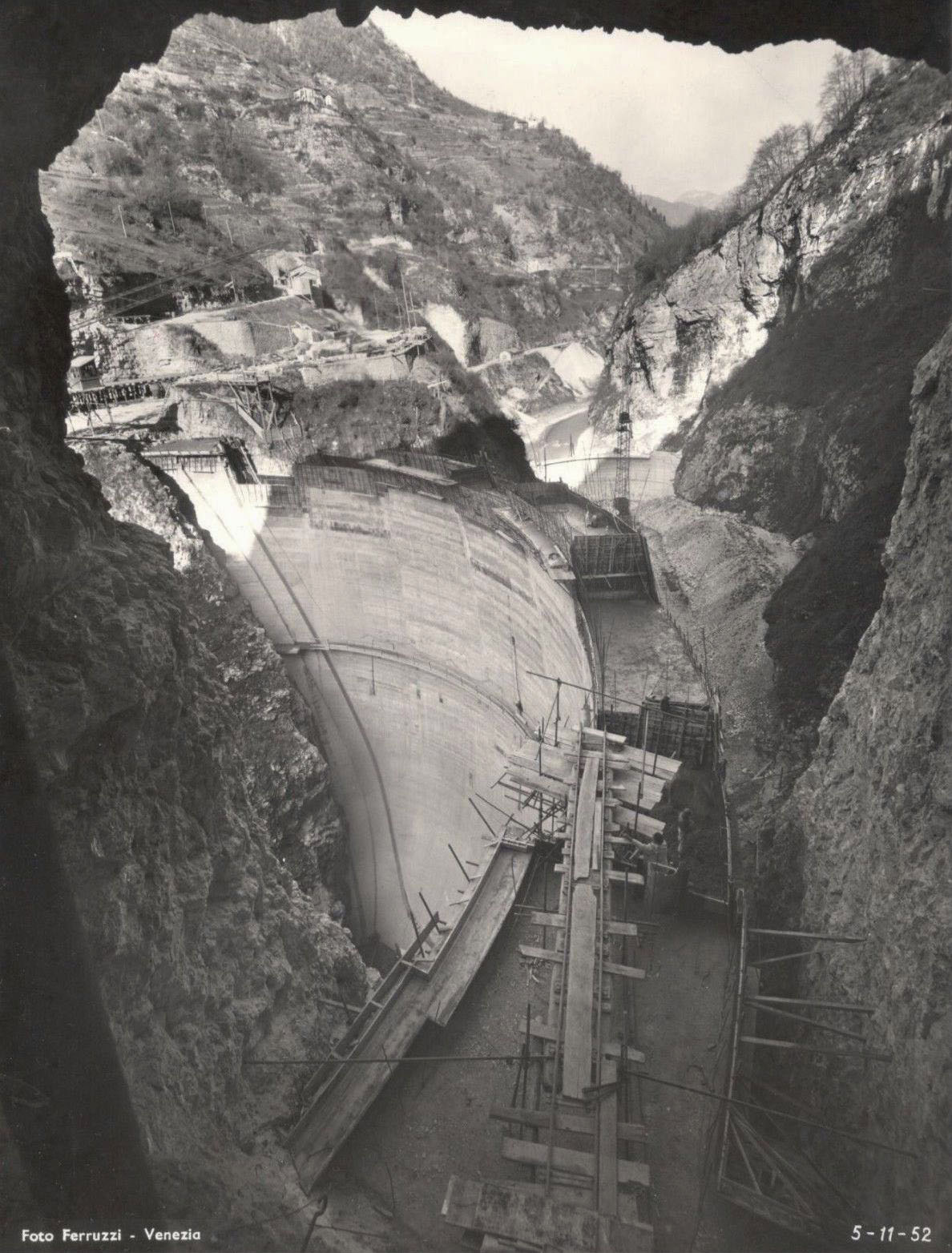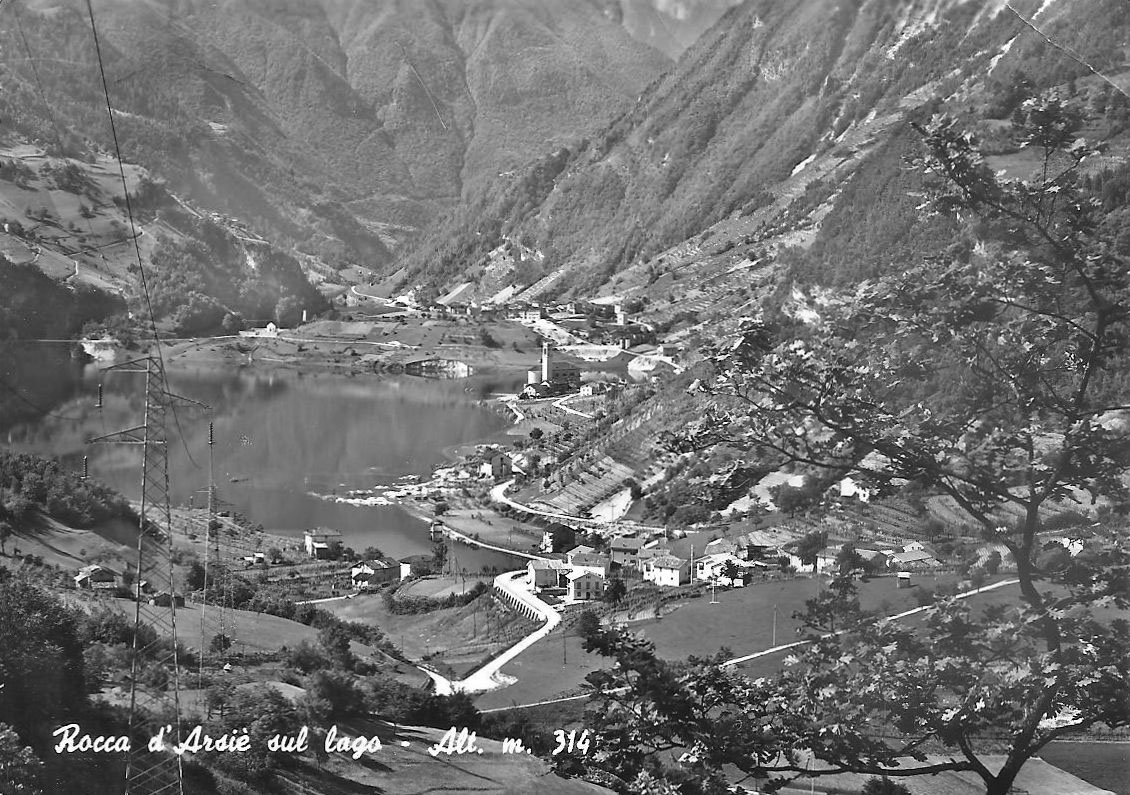Afterward
The History of Lake Corlo
by Silvio Lancerini
When Rocca was connected to Arsiè by a vehicular road in 1908, the first automobile that comes to the village (leading the whole population to pour out into the street to admire it) belongs to the Hydroelectric Company and is carrying a team of executive engineers, coming to evaluate the feasibility of a hydroelectric basin there.

After a long pause resulting from the Great War, the studies and planning resume, and in 1926 the SADE company files an application with the appropriate governmental authorities to erect a hydroelectric basin. Once they are granted the concession, in the 1930s acquisition begins on the pieces of land in the Ligònt Plain, namely in the lower part of the pondage project. In 1937, following an agreement to divide the exploitable watercourses, the granted concession passes from SADE to SMIRREL, but the outbreak of the Second World War interrupts all further development. The project begins in earnest in 1949. The SMIRREL Company starts out, near the Pria bridge, on structuring the dam. Analogous work is also undertaken 300 meters farther downstream, near the small village of Corlo (which the future dam will be named for), by the SAICI Company of the SNIA Viscosa Group.

The people watch astonished at the inconceivable melodrama being played out by advanced engineers who stubbornly insist on trying to build two dams on the same basin. After several months, the two rivals are merged into a single new company: La Basso Cismon S.I.I.A (Società Idroelettrica Irrigazione per Azioni, or Hydroelectric Irrigation Joint-Stock Company). They construct the entire plant without finishing it, since in 1955 there is a yet another handover: the plant is transferred to SELT Valdarno, which completes the remaining work, puts it into operation, and manages it until it is nationalized, when it passes along to ENEL.
In the middle of this tangle of projects, rivalries, and interests, there is the population. A stunned and desperate population, intuitively aware that the environmental and socioeconomic devastation would be enough to annihilate their village community. The seized Ligònt Plain, level with the floodplain of the Cismon, rich in water and extremely fertile, was the local people’s greatest agricultural and economic resource going back to the most remote times.
Since the beginning of the 1950s, all the public authorities give reassurances to the exasperated people, guaranteeing the reconstruction of the demolished buildings and the restoration of infrastructure.
But when the great work “fostering progress and civilization” is finished and the lake begins to rise, the environmental damage is apocalyptic: along the right bank, the piles of debris from demolished districts, all left in their state of collapse, as well as the emptied cemetery, give the entire landscape an air of desolation and death. When the filling of the lake is complete, only a few of the rubble piles crest above the surface as evidence of what happened. The high waters hide the rest of the underlying devastation.

From this moment on nothing more is heard about adequate infrastructure, compensatory construction, or electricity at subsidized prices—the promises made by the public authorities. The exodus of the population, abandoned by everyone, is nearly total, so that of the 3,000 residents a good 2,500 are forced to leave and they disperse into the world.
The valley, born out of the origins of the earth, with its life, history, and culture, had vanished.
Excerpted from the book “The Vanishing Valley” by Silvio Lancerini. Text from magicoveneto.it
Incino, D.I.Y. Government
Twenty Stubborn Residents Keep the Village Alive, Taking Care of the Public Buildings and Streets
by Francesca Valente
Correre delle Alpi, November 29, 2013
Crumbling streets, scant public lighting, water that tastes of chlorine. For more than twenty years the residents of Incino haven’t seen a visit from municipal workers except in emergencies. At this point, major repairs are but a dream. But in the last few years even ordinary maintenance has become wishful thinking.
That’s why a handful of volunteers, dogged residents of a hamlet deprived of services with a depopulation rate at historic highs, understood that it no longer made sense to wait. A year ago they began rebuilding part of the stairs to the church dedicated to the Madonna della salute, whose celebration day is November 21, and rebuilding the access road to the upper part of the town from scratch, excavating the route that runs along the church and paving it with stones and cement. The willing have also started to paint the inside of the church, restore the statues, and clean up the paths. At the limits of their patience, the residents rolled up their sleeves seeking to restore grace and dignity to a village forgotten by all except those determined to live there. Only the materials were provided by the township.
Used for vacation during the summer and as a weekend refuge far from the urban chaos, the hamlet in Arsiè counts just twenty permanent residents. The ones who were born there have no intention of leaving, but there are also some daredevils who, as a vocation, decided to move in up there. Like Dino Maritan, who came to Incino from Padua and two years ago bought the highest ruin in the village to transform it into a made-to-measure home. To reach his house, Maritan has to leave his car in the parking lot at the foot of the hamlet. There is no paved road, just a steep, dark path. Along the way a lady cuts the branches of protruding trees in anticipation of snow.

 Maintenance has become almost a hobby, as well as a way to cultivate friendships. These people don’t mind sheltered life, but they never take it for granted. “When it gets dark, I need a flashlight to move,” says Maritan, “I’ve been asking the town to put in some streetlights for years, a pair would be enough.” On days when it rains a little more than normal, the water that comes from Rocca’s pipes is immediately contaminated with dirt. “And if it isn’t dirty, it tastes like chlorine,” declares Tiziano Zancanaro, “when you brush your teeth you want to vomit.”
Maintenance has become almost a hobby, as well as a way to cultivate friendships. These people don’t mind sheltered life, but they never take it for granted. “When it gets dark, I need a flashlight to move,” says Maritan, “I’ve been asking the town to put in some streetlights for years, a pair would be enough.” On days when it rains a little more than normal, the water that comes from Rocca’s pipes is immediately contaminated with dirt. “And if it isn’t dirty, it tastes like chlorine,” declares Tiziano Zancanaro, “when you brush your teeth you want to vomit.”
For four years the road that connects Incino to Cismon del Grappa has been closed because of rockslide danger. The work is on the list of priorities, but there hasn’t been an agreement between the two provinces to carry it out. This has cut off the lifeblood from the village, forced to use the only remaining access road, which itself is in danger of collapse in two places. In one spot the guard rail is giving way, in the other water is digging an underground tunnel that could open up a chasm in the road at the first opportunity. “If they close via Chiesa too, we’re cut off,” says Walter Zancanaro, the foremost expert on the village’s history. “Ever since the ’90s no substantial work has been done here, but they had forgotten about us even before that.”
There is no gas connection, everyone makes do with propane cylinders and wood stoves. Internet is a mirage, but fortunately there is cellular service, even if not at full coverage. TV, strange to say, receives 50 channels. Mail is delivered regularly, but with certain people it’s left on their car windshields since the route to to their houses is so unforgiving. The bus comes by every other day, but it’s suspected that the service’s days are numbered since so few use it. For food there’s the grocery store in Rocca, otherwise you have to go farther.
On the other side of the dam there is the hamlet of Corlo, which counts just three residents. “But at least it’s lighted,” Maritan says ironically. The median age of the residents is 65. The youngest is 48. The last wedding happened at the end of the ’80s. The last funeral was last year.
The last birth? 38 years ago.